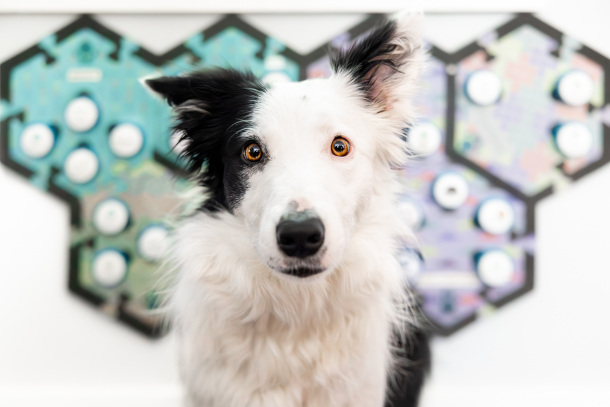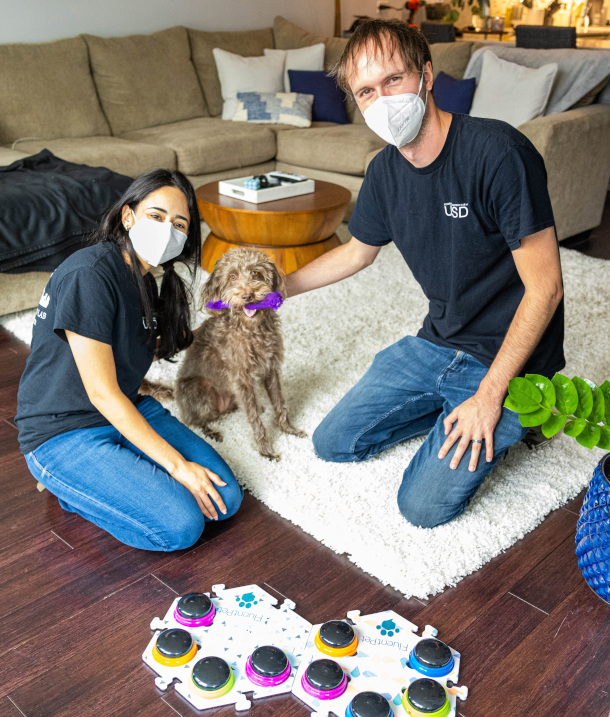Conversations with Dogs
Air Date: Week of October 11, 2024

Although some breeds, such as poodles, learn faster than others, most breeds of dogs can learn to use AIC devices. (Photo: Patrick Wood,Comparative Cognition Lab at UC San Diego)
New research into word comprehension in dogs suggests that with training and special equipment, man’s best friend can in fact understand specific words and reply. Senior author Federico Rossano is a cognitive scientist at UC San Diego and joins Living on Earth’s Steve Curwood to explain why motivation appears to be one of the most important factors driving this ability for dogs to converse in human speech.
Transcript
DOERING: It’s Living on Earth, I’m Jenni Doering.
BELTRAN: And I’m Paloma Beltran.
OWNER: So, we’ve got a treat, or we’ve got some food, which one would you like?
AIS DEVICE: Treat.
OWNER: Treat? Kenny, you know how to do sentences. Show me again!
AIS DEVICE: Kenny want… treat.
OWNER: Kenny want treat! There you go!
BELTRAN: That’s adorable Bichon Frise, Kenny, in a video on his TikTok account thetalkingdogofficial. Kenny can apparently understand specific words and even string together sentences with buttons he’s been trained to press with his paw. And he’s not alone, according to new research into word comprehension in dogs. The study, published in Plos One, recruited dog owners as citizen scientists for one of its experiments. Senior author Federico Rossano is an Associate Professor of Cognitive Science at the University of California, San Diego and joined Living on Earth Host Steve Curwood to explain.
CURWOOD: So many of us have seen those videos on Tiktok, a dog that's going over, pushing a button to say, let me out, or whatever. And the question is, how real is all of this? This is a process you wrote a paper about called augmentative species communication. So, tell me, Professor, what is augmentative species communication, and then describe for us those buttons for listeners who aren't familiar with those videos.
ROSSANO: So, there's a long history of devices that have been used with nonverbal humans to help communicate with others. This could go from pointing to letters on a keyboard to pushing buttons on which a family member might have recorded a word. So, these devices have been in use by humans for a while. And then a few years ago, people tried to use some of these devices with animals, in particular with great apes. And in recent years, not me, other people started using them with dogs. And so, what happened was that when I started seeing that this was going on in many households, and there were people using it on social media with millions of followers, I realized that there was the need of some scientific investigation on what was going on and whether these devices were valuable or just some social media fad that would quickly disappear. And that sort of is what motivated our largest project, and then the specific study that we're going to talk about today.
CURWOOD: We're talking to you because you have a fair amount of evidence that the dogs do understand when they push these buttons, that they're asking folks to either let them out or may perhaps get them something to eat. But how do you train a dog to use these buttons?
ROSSANO: Yeah, the process is called modeling, and it's quite similar to what you do, for example, with a child, where you might describe what you're doing, narrate, in a sense, and then do it. So, you might say, we're going to go outside. And you can push the button, go and the button outside, and then you open the door and go outside. Or you can say, do you want food? Push want food. And then you provide them with food. And of course, if you do it a few times, then the animal would start potentially trying to push those buttons and see what happens next and start learning an association between the use of these buttons and some effect in the world that this buttons can achieve. And sort of, that's how the learning happens, basically, by having human model, kind of narrate, in a sense, through the buttons, what they're doing and producing the appropriate behavior associated with what they're pushing. And then the dogs, ideally getting that kind of behavior response next when they push those buttons.

For his study, Rossano sent researchers into people’s homes to see if their dogs really understand what the words associated with the buttons meant without cues from their owner. (Photo: Comparative Cognition Lab at UC San Diego)
CURWOOD: Now, which kinds of dogs are more adept at this? Because this sounds like a measure of intelligence to learn how to do this.
ROSSANO: It could be. And yet, what I like to tell people who sign up for this study is that you don't need to have a PhD to be able to have conversations with people. So, it's not really about how many words you can get. It's more about are you motivated to interact with others and to communicate with your human? And are you willing to learn? Right? So, what we find is that the dogs who are mainly motivated by praise or play tend to learn a bit better than the ones who are mainly motivated by food. We also find that the ones who tend to be a little more on the anxious side are particularly keen on learning and using these buttons, because, as you can imagine, it can give you some more control over your environment, if you can ask for things and get things more promptly. If you are motivated to interact, if you enjoy learning things and interacting with your human, then there might be a desire to interact also this way. If you are of a breed that is kind of designed to mainly keep people away from your home or be a watchdog in your yard, probably you don't really want to have a lot of chats with humans, you might actually try to keep them away. So, you might not be the best choice for trying to do this training. But again, it doesn't mean that you cannot learn it. It's more like maybe you're not necessarily super motivated.
CURWOOD: How applicable is this to cats?
ROSSANO: It depends a lot on your cat, and also on your patience with your cat, but if they're willing to participate and engage, they're smart animals, and if they can use it to get stuff, they will use it. It's possible. It's definitely possible.
CURWOOD: Professor Rossano, some people say that dogs have the intelligence of, say, a two-year-old or even a two and a half year old human. What's your assessment of that understanding?
href="https://www.tiktok.com/tag/talkingdogsoftiktok?refer=embed">#talkingdogsoftiktok #dogtok #smartdog ♬ original sound - The Chatty Lab
ROSSANO: I honestly think they are quite right. I work with people who make claims that dogs were more like infants, so more like, you know, nine months old or 10 months old, and there was very good evidence for that about 15 years ago, but in the last 15 years, a lot of work has shown us that they can reason about human minds and others. They pay attention to human communications in remarkable ways, and they appear to have the linguistic competence of what would be, at the very least, a toddler, right? So many of these dogs can learn several dozens words. And even in our study, we have about 60 dogs that are more than 100 buttons that they're using on a regular basis. So, you could imagine, once you get to a vocabulary like that, it is indeed analogous to having basically a two-year-old trying to communicate with you.
CURWOOD: Now, one of the concerns with some of these studies regarding animal communication is the so-called Clever Hans effect. Tell us about Hans and the effect that people are concerned about.
ROSSANO: So, Hans was a famous horse that at beginning of the 20th century was famous because people thought it was capable of making mathematical calculations. The reality was that what would happen was that its owner would say something like four plus three, and then Hans was hit his hoof on the ground until would hit seven. And people thought, “Oh, this is amazing. This animal can do it,” until a psychologist observed the process and realized that what Ans was actually doing was paying attention to the faces of its owner first, and if not its owner of the people around him, and when they would see them smile, because it would reach the correct answer, it would just stop hitting his hoof on the ground. So, it was basically particularly capable of processing behavioral cues from humans, and by looking at facial expression was knowing what to do.
This is an important constraint, because, of course, one possibility when we talk about dogs understanding words is that maybe all they pay attention is, for example, intonation. They don't really understand the word. They just pay attention to how you say it, or they pay attention to behavioral cues. So, for example, if I say outside, but what I say, I'm also putting my shoes on or my jacket on, or I'm moving close to the door, we don't really know if the dog is really paying attention to the word, per se, or is also seeing all these other behaviors associated with it that help you figure out, infer that this is actually what's going to happen next. So, we needed to do studies that would try to tease this apart and show that, no, they're really paying attention to the words and not just to the behavioral cues.
CURWOOD: So obviously you wanted to correct for that possibility. What did you do?
ROSSANO: So, what we did is we sent our own experimenters into people's homes. Basically, we had two researchers going to people's homes, one would cover the buttons with stickers so that you wouldn't be able to see what were the signals on the button. And then we're going into another room with the owner, so that the owner would not be in the same room as the dog. And then the second experimenter would be wearing headphones and sunglasses so that you could not just read from the eyes what was going on, and could not hear what button they were pressing, and they couldn't see which one it was, because there were stickers on them. So, they would push the button and then stand still, and the dog would just respond in some way. And then after a certain amount of time, they would push another button and see what the dog would do. And then what we would do is we would have researchers that were not in the household watch video clips without the behavior of the experimenter pushing button, so just watching the response of the dog, not in the same order in which it happened, so that you couldn't just figure out maybe it's the last trial, so it must be this thing. And annotate what they saw in terms of behaviors, and basically predict what was the concept associated with it. The idea was, if I push the button outside, and you understand that, the contextually appropriate response would be for you to move towards the door to go outside. If I push a button, play, then you should look for some toy. If I push the button, food, you should go where food usually is kept or where you receive food. And if you have an appropriate response, contextual, appropriate response, then we can assume that you understand what this word is supposed to elicit as a next action. And that's sort of what we did, and we found evidence that this is indeed the case for the dogs that participate in our study.
CURWOOD: In your studies, what do you find in the way of emotions that dogs can convey? How might they use these buttons to say how they're feeling?

Humans with speech disabilities often use Augmentative and Alternative Communication (AAC) programs to communicate — most commonly via tablet apps like those on an iPad. (Photo: 彭家杰,Wikimedia Commons, CC BY-SA 4.0)
ROSSANO: So, this is work in progress, and of course, as a scientist, I always need to be careful about the claims I make. So, there's clear evidence that these dogs are pushing buttons associated with emotions. Those things will be things like concerned, mad, happy. And some people have asked me, is like, how is that even possible? But again, I have two little children, and I see how my two-year-old is learning emotions and is at school, they show him faces with smiles and frowned faces. And then it's like, happy face, sad face. And when he sees people, he comments on happy or sad based on the mouth position and the rest of the facial expression. So, in many ways, at the beginning, also humans learn, by ways, like you start to associate certain facial expressions with the label, right? It's like happy or sad or concerned or frustrated. And so, what we see is that these animals are using these buttons to label their emotions. For example, one of the things we have seen very often is like, if outside is very loud or if it's hot, they might just complain that they are unhappy. If they're not getting the food that they want, especially if they ask for food and they don't get it, they say they're mad and they're upset. So, I think there's a lot more work that needs to be done, but there are several reasons to believe that there's much more depth and knowledge in these animals than we give them credit for.
CURWOOD: Somebody listening to us, or maybe they've seen the videos online might want to try it at home themselves. To what extent is it safe for people to do this at home themselves, and if so, what are ways that they might get started?
ROSSANO: Yeah, so it is absolutely safe to do it at home yourself. So, there's several brands that you can find online. I don't produce them. I don't sell them. I don't make any money out of this. So, I'm just studying the process, but there are several brands out there. They're not particularly expensive. And you can start with, really just three or four buttons, and not all at the same time. It can start with one. A lot of people start, for example, with a button outside. This becomes part of your routine. Before they go outside, you just push the button outside, and then you go outside and you see if the dog starts pushing for it, and then you take them out. And then you might add another button to the process, and maybe it's play or food or some other buttons along the way. There's a lot of participants, a lot of people out there that really have four or five buttons, and so just some basics of like, I want food, I want water, I need to go pee, and maybe I want to play. That's sort of all you need.
CURWOOD: So, tell me about your hopes of how we could use augmentative interspecies communication to improve the lives of pets and people.

Federico Rossano studies the differences between animal, child, and adult human cognition. His recent work focuses on how pets communicate. (Photo: Comparative Cognition Lab at UC San Diego)
ROSSANO: So, I believe there are many ways in which they could potentially help and at the same time, again, more work is needed. Some of the ways in which I believe they could improve our understanding and the lives of pets is that if we can show systematically that these animals indeed have the intelligence or the communicative abilities of a three-year-old, then you can imagine that the way we interact with them, the way we take care of them, the way we decide, for example, how many hours a day are we willing to leave them alone, or whether we can leave them in shelters and so on and so forth? You know that could be affected. If they can find a way to communicate about pain, and we can then bring them to the vet much earlier, this would potentially extend their life, which, of course, would be beneficial for them. And the general impression is that the use of this devices is particularly beneficial for anxious dogs, for dogs that experience anxiety, which often comes from the difficulty of controlling and predicting the environment around you. And so even just an improvement in terms of control over your environment and the voice that can be heard by your owner, then you're making their lives better. So, at the very least, I think it's gonna improve pets lives. Owners are reporting benefits in terms of improved bonding with their pets because of the training, really, because of the training, obviously, communication leads to improved bonding, as we know. But on the other end, I do think that the very effort you put into doing the training, trying to do something together, it's like working on a project together, creates a bonding experience that I think makes you feel closer.
CURWOOD: What's been the most surprising of your findings?
ROSSANO: There's one thing that had always fascinated me and is the fact that a lot of research with animals is using food as a reward, and it's also focusing on them understanding names or labels of artifacts, objects. And one of the thing I'm seeing with this dogs is how often they actually are asking or pushing the buttons of a person or another animal, another pet in the household that when it's not present, and asking, where are they or what's going on? And to me, this is critical, because while we think that, you know, even in humans, the most important thing is to learn names of objects and names of verbs, the reality is that they are social creatures, just like we are social creatures. And of course, for humans, the first words you learn are mom and dad. Those are the things you care about. And for a dog, when you're not there, they wonder, where are you? To me, was a good reminder of not obsessing over names of toys, but maybe thinking more about what are the social things that a social creature would care about, which is also why play might be more important than other activities that we think are necessary.
BELTRAN: That’s cognitive scientist Federico Rossano of UC San Diego speaking with Living on Earth Host Steve Curwood.
Links
Find out if you and your pet can participate in Rossano’s studies.
Learn more about sound board AIC devices.
Read Rossano’s recent study about AIC communication and dogs.
Living on Earth wants to hear from you!
Living on Earth
62 Calef Highway, Suite 212
Lee, NH 03861
Telephone: 617-287-4121
E-mail: comments@loe.org
Newsletter [Click here]
Donate to Living on Earth!
Living on Earth is an independent media program and relies entirely on contributions from listeners and institutions supporting public service. Please donate now to preserve an independent environmental voice.
NewsletterLiving on Earth offers a weekly delivery of the show's rundown to your mailbox. Sign up for our newsletter today!
 Sailors For The Sea: Be the change you want to sea.
Sailors For The Sea: Be the change you want to sea.
 The Grantham Foundation for the Protection of the Environment: Committed to protecting and improving the health of the global environment.
The Grantham Foundation for the Protection of the Environment: Committed to protecting and improving the health of the global environment.
 Contribute to Living on Earth and receive, as our gift to you, an archival print of one of Mark Seth Lender's extraordinary wildlife photographs. Follow the link to see Mark's current collection of photographs.
Contribute to Living on Earth and receive, as our gift to you, an archival print of one of Mark Seth Lender's extraordinary wildlife photographs. Follow the link to see Mark's current collection of photographs.
 Buy a signed copy of Mark Seth Lender's book Smeagull the Seagull & support Living on Earth
Buy a signed copy of Mark Seth Lender's book Smeagull the Seagull & support Living on Earth

